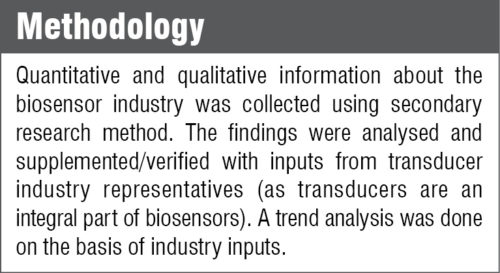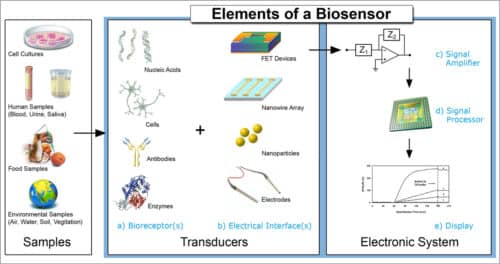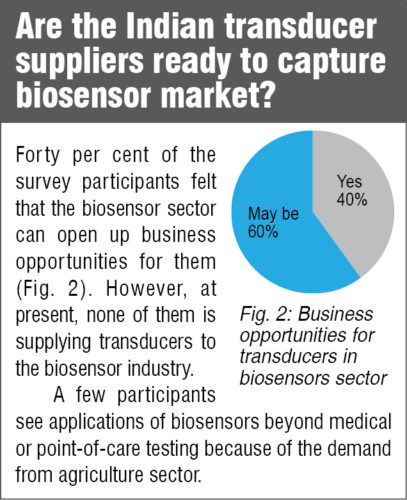Biosensors are analytical devices that combine a bioreceptor (biological recognition element) and a transducer. The bioreceptor can be organisms, tissues, cells, enzymes, antibodies, nucleic acids, etc. It detects the target analyte. The transducer can be electrochemical, optical, thermal or mechanical in nature. It converts the detected analyte into a measurable signal. Therefore biosensors involve cross-functional interaction among disciplines such as electronics, electrical engineering, biology and chemistry.
Biosensors offer high-quality output, accuracy, precision, specificity and sensitivity within affordable prices. These are considered as essential devices with the ability of quick detection. They are ideal for providing low-cost, easy, quick and portable solutions.
In a typical biosensor, the biological recognition unit interacts with biological samples/bio-elements, which include enzymes, living tissues and antibodies. Subsequently, transducers transform the signals generated from this interaction into an electrical signal.
There is a huge market for biosensors in healthcare as well as food industry for diagnostics and testing of food, soil, water, environment, etc. Moreover, the demand for biosensors translates into the demand for transducers.

Market potential
According to AMERI Research, the global biosensors market was valued at $15.4 billion in 2016 and will significantly grow at 9.2 per cent per cent annually to reach $31 billion in 2024 (Fig. 1).

In terms of value, North America leads the market with a share of about 37 per cent in 2015. High disease burden and the subsequent need to curb associated healthcare expenditure has resulted in the US accounting for a large share of the North American market in 2014. According to the Centers of Disease Control (CDC), around 22.3 million people in the US were diagnosed with diabetes in the year 2013. (Biosensors are a key element in the glucose monitoring device.) However, presence of other alternatives for diabetes management, such as laboratory methods, is expected to limit market growth.

Asia Pacific is anticipated to witness significant growth during the forecast period. China and India are expected to spearhead growth in the region. The increasing number of people suffering from diabetes and government initiatives toward improvement of the healthcare sector are boosting the demand for glucose monitors (which use biosensors) in Asia Pacific region.
Market drivers
Increasing prevalence of chronic and lifestyle-induced diseases, rising demand for point-of-care (POC) testing or applications, growing geriatric population, and their application in nanotechnology are key growth drivers for the biosensor market. Rapid technological advancements and expanded application areas in medical science are also important growth influencers. In addition, the mounting demand for cost-efficient, disposable and user-friendly devices is likely to spur growth.

However, growth can be realised only after existing hurdles are removed. Reimbursement policies in healthcare systems, stringent regulatory requirements and high cost of R&D are among the major challenges.
The biosensors market can be segmented on the basis of application and technology.
The application segment comprises food toxicity detection, industrial process control, medicine/diagnostics/point-of-care testing and other application areas such as environment and agriculture. The industry is witnessing increasing use of these devices in laboratories, point-of-care testing and self-testing.
Medical and diagnostics applications including POC testing dominate the market. POC applications can be segmented into glucose monitoring, cardiac markers, infectious disease diagnosis, coagulation monitoring, pregnancy and fertility testing, blood gas and electrolytes testing, tumour or cancers markers, urinalysis testing, cholesterol tests, etc.
Cardiac markers are the most dynamic POC application and are expected to witness several innovations and investments over the next five years, owing to the increasing number of people suffering from cardiovascular diseases and rising demand for instant diagnosis of these diseases.
By 2022, glucose monitoring is likely to hold the largest share of biosensors market for point-of-care applications. Blood glucose monitoring plays a crucial role in diabetes management. Glucose biosensors provide real-time information on the changes in glucose concentration. The glucose biosensors technology helps maintain normal blood glucose levels. The rising prevalence of diabetes worldwide, technological advancements in self-monitoring of blood glucose, and growing awareness about POC testing are the key factors boosting the demand for glucose monitoring biosensors. Among all applications, glucose monitoring held the largest size of biosensors in 2016.
The glucose biosensors industry is segmented on the basis of its end use in hospitals, homecare diagnostics and others including research institutes and diagnostics and clinical laboratories. The homecare diagnostics market for glucose biosensors is projected to flourish over the forecast period 2015-22. Ease-of-use, quick results and low costs of the tests are supporting market growth. On the other hand, hospital-based market is projected to grow at a significant CAGR of 10.3 per cent during this period.

Based on the technology, the biosensors market is segmented into electrochemical, thermal, optical and piezoelectric markets.Innovations in electrochemical sensors with high-throughput methods focusing on detection limit, analysis time and portability have provided large-scale consumer markets for inexpensive biosensors in glucose and pregnancy tests.
Optic-based biosensors involving fibre-optic chemistry are the next major technology in biosensing. Optical biosensors for DNA measurement find applications in biomedicine and forensic science.

Moreover, integrated strategies using multiple technologies ranging from electrochemical, electromechanical and fluorescence-cum-optical-based biosensors and genetically engineered microbes are modern methods for biosensor discoveries. Development of different micro- and nano-biosensor platforms involving integrated technologies utilising electrochemical or optic bio-electronic principles with a combination of biomolecules or biological materials, polymers and nanomaterials is required to achieve highly sensitive and miniaturised devices.







